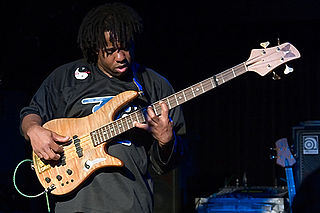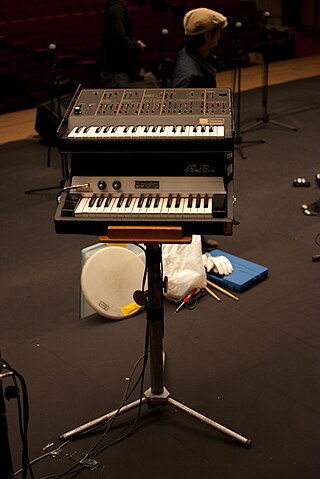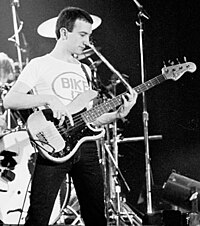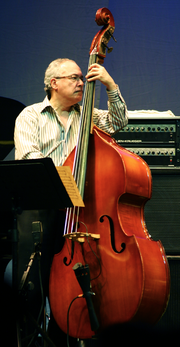
The double bass, also known as the upright bass for distinguishing purposes, or simply as the bass, is the largest and lowest-pitched chordophone, in the modern symphony orchestra. Similar in structure to the cello, it has four or five strings.

Funk is a music genre that originated in African-American communities in the mid-1960s when musicians created a rhythmic, danceable new form of music through a mixture of various music genres that were popular among African-Americans in the mid-20th century. It deemphasizes melody and chord progressions and focuses on a strong rhythmic groove of a bassline played by an electric bassist and a drum part played by a percussionist, often at slower tempos than other popular music. Funk typically consists of a complex percussive groove with rhythm instruments playing interlocking grooves that create a "hypnotic" and "danceable" feel. It uses the same richly colored extended chords found in bebop jazz, such as minor chords with added sevenths and elevenths, and dominant seventh chords with altered ninths and thirteenths.

Jazz guitar may refer to either a type of electric guitar or a guitar playing style in jazz, using electric amplification to increase the volume of acoustic guitars.

A musical ensemble, also known as a music group or musical group, is a group of people who perform instrumental and/or vocal music, with the ensemble typically known by a distinct name. Some music ensembles consist solely of instrumentalists, such as the jazz quartet or the orchestra. Other music ensembles consist solely of singers, such as choirs and doo wop groups. In both popular music and classical music, there are ensembles in which both instrumentalists and singers perform, such as the rock band or the Baroque chamber group for basso continuo and one or more singers. In classical music, trios or quartets either blend the sounds of musical instrument families or group together instruments from the same instrument family, such as string ensembles or wind ensembles. Some ensembles blend the sounds of a variety of instrument families, such as the orchestra, which uses a string section, brass instruments, woodwinds and percussion instruments, or the concert band, which uses brass, woodwinds and percussion.

In music performances, rhythm guitar is a technique and role that performs a combination of two functions: to provide all or part of the rhythmic pulse in conjunction with other instruments from the rhythm section ; and to provide all or part of the harmony, i.e. the chords from a song's chord progression, where a chord is a group of notes played together. Therefore, the basic technique of rhythm guitar is to hold down a series of chords with the fretting hand while strumming or fingerpicking rhythmically with the other hand. More developed rhythm techniques include arpeggios, damping, riffs, chord solos, and complex strums.

A bass musical instrument produces tones in the low-pitched range C2–C4. Basses belong to different families of instruments and can cover a wide range of musical roles. Since producing low pitches usually requires a long air column or string, the string and wind bass instruments are usually the largest instruments in their families or instrument classes.

Bassline is the term used in many styles of music, such as blues, jazz, funk, dub and electronic, traditional, and classical music, for the low-pitched instrumental part or line played by a rhythm section instrument such as the electric bass, double bass, cello, tuba or keyboard.

Accompaniment is the musical part which provides the rhythmic and/or harmonic support for the melody or main themes of a song or instrumental piece. There are many different styles and types of accompaniment in different genres and styles of music. In homophonic music, the main accompaniment approach used in popular music, a clear vocal melody is supported by subordinate chords. In popular music and traditional music, the accompaniment parts typically provide the "beat" for the music and outline the chord progression of the song or instrumental piece.
In jazz, comping is the chords, rhythms, and countermelodies that keyboard players, guitar players, or drummers use to support a musician's improvised solo or melody lines. It is also the action of accompanying, and the left-hand part of a solo pianist.

A guitar solo is a melodic passage, instrumental section, or entire piece of music, pre-written to be played on a classical, electric, or acoustic guitar. In 20th and 21st century traditional music and popular music such as blues, swing, jazz, jazz fusion, rock and heavy metal, guitar solos often contain virtuoso techniques and varying degrees of improvisation. Guitar solos on classical guitar, which are typically written in musical notation, are also used in classical music forms such as chamber music and concertos.

A rhythm section is a group of musicians within a music ensemble or band that provides the underlying rhythm, harmony and pulse of the accompaniment, providing a rhythmic and harmonic reference and "beat" for the rest of the band. The rhythm section is often contrasted with the roles of other musicians in the band, such as the lead guitarist or lead vocals whose primary job is to carry the melody.

Jazz bass is the use of the double bass or electric bass guitar to improvise accompaniment ("comping") basslines and solos in a jazz or jazz fusion style. Players began using the double bass in jazz in the 1890s to supply the low-pitched walking basslines that outlined the chord progressions of the songs. From the 1920s and 1930s Swing and big band era, through 1940s Bebop and 1950s Hard Bop, to the 1960s-era "free jazz" movement, the resonant, woody sound of the double bass anchored everything from small jazz combos to large jazz big bands.

Keyboard bass is the use of a smaller, low-pitched keyboard with fewer notes than a regular keyboard or pedal keyboard to substitute for the deep notes of a bass guitar or double bass in music.

Bass pedals are an electronic musical instrument with a foot-operated pedal keyboard with a range of one or more octaves. The earliest bass pedals from the 1970s consisted of a pedalboard and analog synthesizer tone generation circuitry packaged together as a unit. The bass pedals are plugged into a bass amplifier or PA system so that their sound can be heard. Since the 1990s, bass pedals are usually MIDI controllers, which have to be connected to a MIDI-compatible computer, electronic synthesizer keyboard, or synth module to produce musical tones. Some 2010s-era bass pedals have both an onboard synth module and a MIDI output.

A guitar technician is a member of a music ensemble's road crew who maintains and sets up the musical equipment for one or more guitarists. Depending on the type and size of band, the guitar tech may be responsible for stringing, tuning, and adjusting electric guitars and acoustic guitars, and maintaining and setting up guitar amplifiers and other related electronic equipment such as effect pedals.

This is a glossary of jazz and popular music terms that are likely to be encountered in printed popular music songbooks, fake books and vocal scores, big band scores, jazz, and rock concert reviews, and album liner notes. This glossary includes terms for musical instruments, playing or singing techniques, amplifiers, effects units, sound reinforcement equipment, and recording gear and techniques which are widely used in jazz and popular music. Most of the terms are in English, but in some cases, terms from other languages are encountered.
Dixieland jazz, also referred to as traditional jazz, hot jazz, or simply Dixieland, is a style of jazz based on the music that developed in New Orleans at the start of the 20th century. The 1917 recordings by the Original Dixieland Jass Band, fostered awareness of this new style of music.

The following outline is provided as an overview of and topical guide to jazz:

Heavy metal bass is the use of the bass guitar in the rock music genres of heavy metal and hard rock. The bassist is part of the rhythm section in a heavy metal band, along with the drummer, rhythm guitarist and, in some bands, a keyboard player. The prominent role of the bass is key to the metal sound, and the interplay of bass and distorted electric guitar is a central element of metal. The bass guitar provides the low-end sound crucial to making the music "heavy". The bass plays a crucial role in heavy metal and a more important role than in traditional rock."

A rock band or pop band is a small musical ensemble that performs rock music, pop music, or a related genre. A four-piece band is the most common configuration in rock and pop music. In the early years, the configuration was typically two guitarists, a bassist, and a drummer. Another common formation is a vocalist who does not play an instrument, electric guitarist, bass guitarist, and a drummer. Instrumentally, these bands can be considered as trios. Sometimes, in addition to electric guitars, electric bass, and drums, also a keyboardist plays.


























